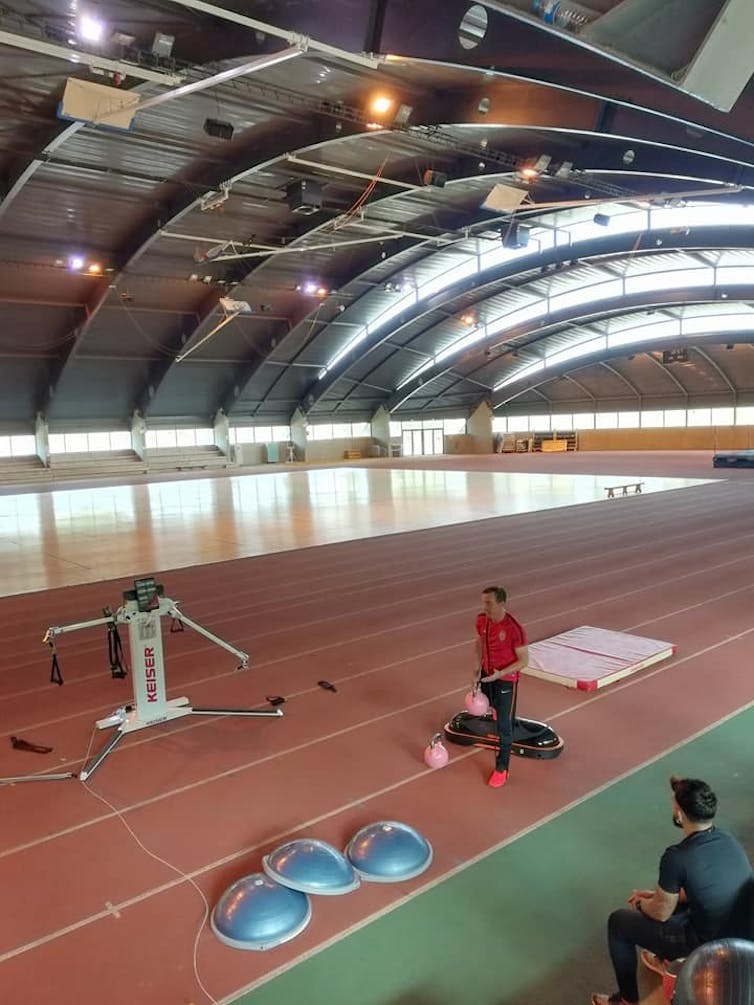Science invites itself into the world of soccer
Soccer is a game of movement: typically, soccer players cover 8 to 12 km in a match lasting around 90 minutes, with a heart rate maintained at 80-90% of maximum values.
Stéphane Perrey, University of Montpellier

Joshua Hoehne on Unsplash, CC BY-SA
In addition to the specific endurance needed to cope with the physiological demands of the match, soccer players face another challenge: sprinting more often and faster according to spatio-temporal constraints in order to perform well!
Against this backdrop, the Association des Préparateurs Physiques du Football Professionnel, represented by its President Sébastien Lopez-Guia, an FFF professional physical trainer, recognized as the association of the majority of soccer specialists on the French professional and amateur circuit, has joined forces with the University of Montpellier (Laurent Mortel and Stéphane Perrey) to create a unique training program: the Diplôme Universitaire d'Optimisation de la Performance en Football (University Diploma in Football Performance Optimization). With the association, different approaches to athletic preparation for footballers are developed in professional clubs. The course meets a growing demand for a hyper-specialized diploma that combines targeted scientific skills with the kind of on-the-job expertise that is applied today in all top-level clubs. With the help of human movement sciences, it is now possible to identify motor signatures in soccer.
Strength in motion: "useful" strength for footballers
Being able to produce both rapid force and high muscular power are considered to be among the most important physical performance characteristics, particularly in activities that rely on repetition of jumps, changes of direction and/or speed.
Soccer, for example, is subject to numerous movement sequences requiring the ability to perform "explosive" actions such as acceleration or deceleration, sprints and jumps, depending on the position occupied on the pitch.
Statistics tell us that players cover an average sprint distance (≥ 24 km-h-1) of 250 meters per match, with players reaching top speeds of around 32 km-h-1. Soccer players are also required to perform around 60 sprint sequences per match while making several changes of direction and jumping actions. What these forms of movement have in common is that they generate large amounts of force in relatively short periods of time.
How do you strengthen yourself to move better?
Strength training is often equated with, or even reduced to, increasing muscle mass. While this is partly true, there are other aspects to strength topography, such as "explosive" strength, endurance strength, speed strength, etc., each corresponding to different muscular qualities that can be specifically trained in Football.

Stephane Perrey, Author provided
One of the areas of modern physical preparation that is experiencing a revival is so-called functional training. Functional training aims to integrate the needs and constraints of the sporting situation into the training environment in order to improve training efficiency. In other words, functional training to develop "explosive" strength and power must be seen as training in which the exercises and movements proposed are integrated, multidirectional and enriched in a propitious way.
In practice, functional training involves a range of movements based on kinetic chain exercises (a set of muscles involved), ballistic movements such as throwing weighted balls, and dynamic balance activities calling on proprioception and sheathing qualities.
The principle is to work the muscle chains as a whole, targeting the major physiological and neuromuscular systems. In contrast to more traditional bodybuilding training, known as analytical training, which focuses on one or more muscles in isolation, functional training takes into account the entire muscular chain and joints. Upper and lower limbs work together, not in isolation.
Gone are the repetitive barbell lifts, replaced by global exercises using simple to complex explosive movements based on individual creativity. Functional work can be carried out in the form of workshops (circuit training type), bodyweight (equipment-free exercises) or with various accessories (elastic bands, unstable supports, weights, straps, etc.) and specialized machines.
Movements that don't lack control
The aim of functional training is to contextualize game situations as closely as possible to the training environment. However, cognitive requirements are often overlooked in the context of strength training in isolation. Successful performance requires physiological and cognitive skills that are dependent on, or linked to, each other. Achieving neuromuscular adaptations specific to the footballer's movement patterns requires the control of two types of effort: physical effort and mental effort. Once again, functional training can provide a solution to this problem.
An important element in the principle of training specificity is the intention subordinated to muscular action and the nature of the effort. A key training stimulus is the nature of the motor command and the resulting motor unit activation patterns associated with high-speed movements.
These central motor commands activate the muscles in a manner consistent with the intention and, in addition, promote specific physiological adaptations. The nature of the mental effort directly influences the quality and quantity of the movement and, consequently, all the physiological adaptations and , ultimately, the final performance.
This could lead to more efficient patterns of muscle coordination and contraction because we're not just training muscles, but intending to train movement! For example, bouncing when jumping must be the intention, and jumping becomes a means to an end, but not the goal. Applied to the context of training, we learn better to perceive the effectiveness of a movement when we discover solutions ourselves through the free exploration of the repertoire of movements available to us: this is the added value offered by functional training assisted or not by external resistance.
![]() The functional training approach described is designed to improve the specificity of the underlying physiological adaptations to the types of movements to be produced, and not to improve perceptual and cognitive abilities. Functional training is not exclusive. Other methods of strength development are needed to achieve other objectives in terms of muscular adaptations, such as increasing muscle size, which are integral components of functional performance. The various markers of the footballer's movement (cognitive, physiological, neuromuscular, sensorimotor) would thus constitute a behavioural map contributing to the precision of diagnostic predictors of performance. It's perhaps only a short step from there to saying that the intelligence of the game can be seen in the fingerprints of players' movements.
The functional training approach described is designed to improve the specificity of the underlying physiological adaptations to the types of movements to be produced, and not to improve perceptual and cognitive abilities. Functional training is not exclusive. Other methods of strength development are needed to achieve other objectives in terms of muscular adaptations, such as increasing muscle size, which are integral components of functional performance. The various markers of the footballer's movement (cognitive, physiological, neuromuscular, sensorimotor) would thus constitute a behavioural map contributing to the precision of diagnostic predictors of performance. It's perhaps only a short step from there to saying that the intelligence of the game can be seen in the fingerprints of players' movements.
Stéphane Perrey, University Professor, Deputy Director of the EuroMov laboratory, University of Montpellier
The original version of this article was published on The Conversation.